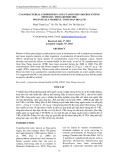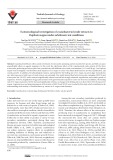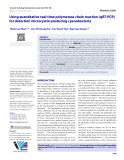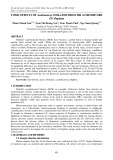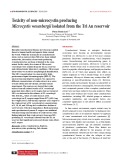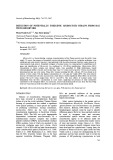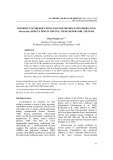
Microcystin producing
-
Blooms of blue-green algae (cyanobacteria) occur in freshwater as well as marine environments and cause negative impacts to other organisms via production of natural toxins. Microcystins (MCs), producing by many species of cyanobacteria, cause liver damage, cancer, mental disorder and seriously effects on human health.
 10p
10p  vikissinger
vikissinger
 03-03-2022
03-03-2022
 13
13
 1
1
 Download
Download
-
Cyanobacterial blooms often consist of mixtures of microcystin-producing and microcystin-free species, and both can cause unpredictable effects on aquatic organisms. In this work, the subchronic effects of the cyanobacterial crude extracts (CCEs) from microcystin-producing and microcystin-free cyanobacteria with different microcystin concentrations (1, 10, and 50 µgL−1)on Daphnia magna were investigated. The life-history trait responses of D. magna to CCEs were determined based on survival, reproduction, and somatic growth.
 10p
10p  dolomite36
dolomite36
 30-12-2021
30-12-2021
 9
9
 0
0
 Download
Download
-
Results showed that the Microcystis genus dominated the cyanobacterial communities in the TAR. Microcystis was also the primary microcystins (MC) producing cyanobacteria in the water. Total cyanobacteria and Microcystis cells ranged from 152×103 to 27×106 copy/L and from 105×103 to 19×106 copy/L, respectively. The cell number of potentially MC-producing cyanobacteria (corresponding to the Microcystis mcyDgene) varied from 27×103 to 13×106 copy/L.
 8p
8p  spiritedaway36
spiritedaway36
 28-11-2021
28-11-2021
 11
11
 0
0
 Download
Download
-
Harmful cyanobacterial blooms (HCB) have become a global threat to human health and aquatic biota around the world. While the ecotoxicity of microcystins (MC) producing cyanobacteria such as Microcystis spp. has been studied extensively, little is known about toxic effects of others filamentus cyanobacteria such as Anabaena spp. In this study, several strains of Anabaena sp. were isolated from Tri An Reservoir and cultured under laboratory conditions. Microscopic observation was used for morphological identification.
 4p
4p  viwinter2711
viwinter2711
 05-10-2021
05-10-2021
 15
15
 1
1
 Download
Download
-
The presence of Blue-green algae (BGA) toxins in surface water sources and recreation is receiving increasing attention around the world as a public health concern. However, potential risks from exposure to these toxins in contaminated health food products that contain BGA have been largely ignored. Toxic BGA produces compound called microcystin. Fine-grained sediment is a natural and essential component of river systems and plays a major role in the hydrological, geo-morphological and ecological functioning of rivers.
 13p
13p  kethamoi4
kethamoi4
 16-04-2020
16-04-2020
 15
15
 1
1
 Download
Download
-
Harmful cyanobacterial blooms have become a global threat to human health and aquatic biota around the world. While the ecotoxicity of cyanobacterial toxins such as microcystins (MCs) has been studied extensively, the toxicity of non-toxin producing cyanobacteria has not been evaluated to the same extent. In this study, five strains of Microcystis wesenbergii were isolated from the Tri An reservoir and cultured under laboratory conditions. Microscopic observation was used for morphological identification. The MCs concentration was measured by highperformance liquid chromatography (HPLC).
 6p
6p  chauchaungayxua2
chauchaungayxua2
 07-01-2020
07-01-2020
 36
36
 1
1
 Download
Download
-
Microcystis is a bloom-forming, common cyanobacterium in Dau Tieng reservoir used for public water supply. To assess the presence of potentially microcystin-producing Microcystis, molecular techniques were conducted and acute toxicity bioassays were performed with the microcrustacean Daphnia magna exposed to cyanobacterial crude extracts. Potentially toxigenic of isolated strains was characterized by amplifying mcyD genes and identification of Microcystis was confirmed by 16S rRNA amplification.
 8p
8p  viathena2711
viathena2711
 08-10-2019
08-10-2019
 12
12
 0
0
 Download
Download
-
In this study, a 16S rDNA clone library was used to evaluate the diversity of potential microcystin producing cyanobacteria and polymerase chain reaction (PCR) was used to analyze the diversity of this population based on the presence of the mcyD gene in samples collected during a bloom season. The results revealed that Microcystis genera from the Dau Tieng reservoir (DTR) contained several genotypes. The isolated Microcystis strains from the DTR were found to consist both toxic and non-toxic species within species and population.
 10p
10p  shiwo_ding7
shiwo_ding7
 05-06-2019
05-06-2019
 11
11
 0
0
 Download
Download
CHỦ ĐỀ BẠN MUỐN TÌM








